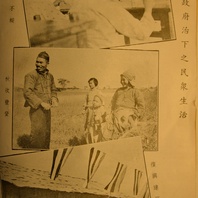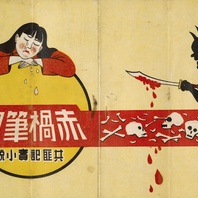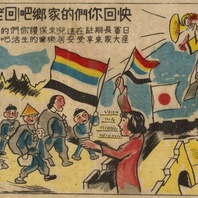
Item
Weixin zhengfu zhixia zhi minzhong shenghuo (The life of the masses under the Reformed Government)
This series of unattributed photographs is taken from the Daminhui publication Xin Zhongguo (New China) 3.1 (January 1940). They are used here to present scenes of life under the rule of the Reformed Government (Weixin zhengfu), or RGROC, which was a “client regime” established in 1938. The RGROC was eventually amalgamated with Wang Jingwei’s RNG in March 1940. The top image is entitled “xian’ge bu chuo” (“studying never stops, even in times of strife”); the middle image is entitled “qiu shou fengdeng” (gathering the autumn harvest); the image at the bottom of the page is entitled “fuxing jianzhu” (renovating buildings). All three are typical images of the sort that the Daminhui promoted in the period between 1938 and 1940, but also display a clear influence from Manchukuo propaganda photography from earlier in the 1930s.
Read More

Item
Chihuo biji: Gongfei jishi xiaoshuo(A record of the Red Peril: A novel recording the deeds of the Communist bandits)
This book, almost certainly produced by the Japanese military, tells the story of communist violence against Chinese peasants in wartime Shanxi, and the escape of an anti-communist Chinese peasant girl to occupied Beijing. It was clearly written to discourage civilian support for the communist resistance in north China, and to foster peasant support for the newly-established PGROC early in the occupation. The weeping peasant woman is juxtaposed to the sinister “devil” that is international communism.
Read More

Item
Kuai hui nimen de jiaxiang ba! (Hurry back to your homes!)
This leaflet, produced with the aim of encouraging civilians in occupied north China to return to cities and towns under Japanese rule, includes many of the standard tropes of early occupied north China propaganda: a “new woman”; city walls; the “five-coloured flag” (wuseqi). The text on the leaflet reads: “Hurry back to your homes! Return to your hometowns! The Japanese army will be here for a long time. Come and protect your livelihoods and your assets. Everyone can savour living in peace and enjoying their work again”.